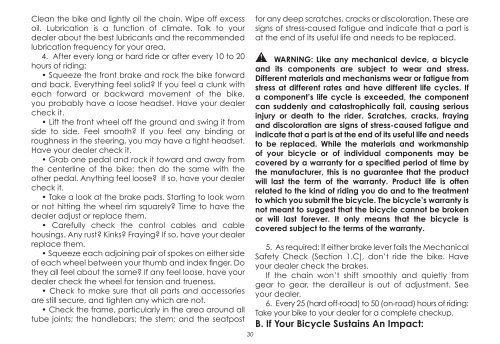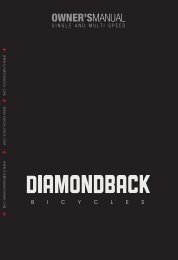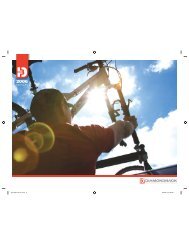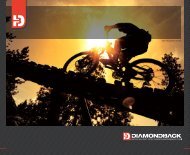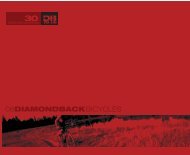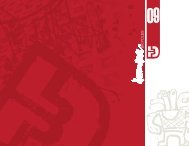Owner's Manual - Diamondback Bicycles
Owner's Manual - Diamondback Bicycles
Owner's Manual - Diamondback Bicycles
You also want an ePaper? Increase the reach of your titles
YUMPU automatically turns print PDFs into web optimized ePapers that Google loves.
Clean the bike and lightly oil the chain. Wipe off excessoil. Lubrication is a function of climate. Talk to yourdealer about the best lubricants and the recommendedlubrication frequency for your area.4. After every long or hard ride or after every 10 to 20hours of riding:• Squeeze the front brake and rock the bike forwardand back. Everything feel solid? If you feel a clunk witheach forward or backward movement of the bike,you probably have a loose headset. Have your dealercheck it.• Lift the front wheel off the ground and swing it fromside to side. Feel smooth? If you feel any binding orroughness in the steering, you may have a tight headset.Have your dealer check it.• Grab one pedal and rock it toward and away fromthe centerline of the bike; then do the same with theother pedal. Anything feel loose? If so, have your dealercheck it.• Take a look at the brake pads. Starting to look wornor not hitting the wheel rim squarely? Time to have thedealer adjust or replace them.• Carefully check the control cables and cablehousings. Any rust? Kinks? Fraying? If so, have your dealerreplace them.• Squeeze each adjoining pair of spokes on either sideof each wheel between your thumb and index finger. Dothey all feel about the same? If any feel loose, have yourdealer check the wheel for tension and trueness.• Check to make sure that all parts and accessoriesare still secure, and tighten any which are not.• Check the frame, particularly in the area around alltube joints; the handlebars; the stem; and the seatpost30for any deep scratches, cracks or discoloration. These aresigns of stress-caused fatigue and indicate that a part isat the end of its useful life and needs to be replaced.! WARNING: Like any mechanical device, a bicycleand its components are subject to wear and stress.Different materials and mechanisms wear or fatigue fromstress at different rates and have different life cycles. Ifa component’s life cycle is exceeded, the componentcan suddenly and catastrophically fail, causing seriousinjury or death to the rider. Scratches, cracks, frayingand discoloration are signs of stress-caused fatigue andindicate that a part is at the end of its useful life and needsto be replaced. While the materials and workmanshipof your bicycle or of individual components may becovered by a warranty for a specified period of time bythe manufacturer, this is no guarantee that the productwill last the term of the warranty. Product life is oftenrelated to the kind of riding you do and to the treatmentto which you submit the bicycle. The bicycle’s warranty isnot meant to suggest that the bicycle cannot be brokenor will last forever. It only means that the bicycle iscovered subject to the terms of the warranty.5. As required: If either brake lever fails the MechanicalSafety Check (Section 1.C), don’t ride the bike. Haveyour dealer check the brakes.If the chain won’t shift smoothly and quietly fromgear to gear, the derailleur is out of adjustment. Seeyour dealer.6. Every 25 (hard off-road) to 50 (on-road) hours of riding:Take your bike to your dealer for a complete checkup.B. If Your Bicycle Sustains An Impact:


